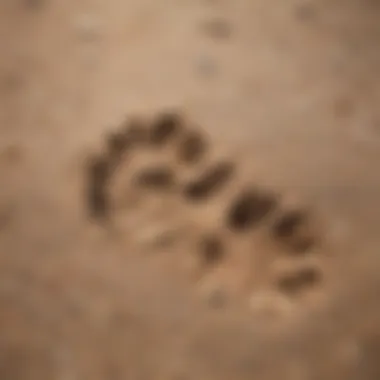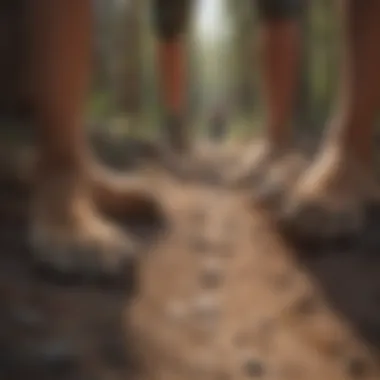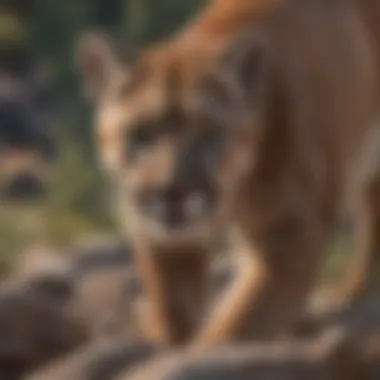Understanding Mountain Lion Tracks: A Young Explorer's Guide


Nature Topic Overview
Mountain lions, also known as cougars or pumas, are fascinating creatures that roam the wild landscapes of North America. While these animals remain elusive, they leave behind tracks that can help us understand their presence. Knowing how to identify mountain lion tracks gives young explorers insights into wildlife, enhances their outdoor adventures, and cultivates a deeper respect for nature.
This guide is designed for young explorers who want to decode the stories told by wildlife through signs like tracks. We will cover different aspects such as the anatomy of mountain lion paws and how these unique tracks can vary in size and shape, depending on several factors such as age, terrain, and grooming habits. Let's embark on this journey of discovery together.
Fun Facts and Trivia
Here are some intriguing facts that can captivate young readers and spark their curiosity:
- Largest Wild Cat in North America: The mountain lion is the largest in the North American wild cat family, often confusing even seasoned wildlife observers.
- Keen Observers: Mountain lions are territorial. They use their tracks to leave signals for other mountain lions to follow or avoid.
- Silent Movement: These animals can sneak through the woods silently, but their tracks reveal where they have been.
Engaging visuals, such as footprints and images comparing mountain lion tracks to those of similar species like bobcats, can create a captivating learning moment.
“Tracks are like footprints of nature, revealing secrets that animals wish to share.”
Wildlife Explorations
In exploring mountain lion tracks, it is essential to learn about other animals in the ecosystem. For instance, consider the bobcat or the fox. These animals, while smaller than mountain lions, also leave tracks that vary in size and shape.
Animal Tracks
- Bobcat Tracks: Smaller than mountain lion tracks, bobcats have round serrations, usually measuring around 1.5 to 3.5 inches wide.
- Fox Tracks: Even smaller and closer together, fox tracks may show claw marks and measure about 2 to 3 inches.
Each track tells different stories of animal behavior and habitat, promoting lots of outdoor observation opportunities for curious children.
Environmental Awareness
Understanding mountain lion tracks fosters greater awareness of environmental conservation. Wildlife conservation is critical. Young explorers should recognize:
- The significance of deepening respect for nature
- Eco-friendly ways to enjoy the outdoors, such as keeping a safe distance from wildlife and minimizing echo distress to animal habitats
Kids can easily follow these steps to help protect their local flora and fauna:
- Stay on trails to prevent plant damage.
- Keep your noise down when exploring to avoid startling animals.
Conservation matters can resonate deeply within younger audiences, as they can assist directly in protecting their surrounding environments.
DIY Nature Activities
Hands-on activities engage young explorers through fun and active learning:
- Track Mapping: Encourage children to create a simple map of the area. They can then mark where they find various animal tracks during an outdoor expedition.
- Crafting Tracks: Kids can create tracks out of clay to distinguish how mountain lions' tracks differ from others.
- Nature Journals: Facilitate exploration by suggesting kids keep journals to sketch observed tracks and note down details.
These activities not only solidify their understanding but also allow them to apply their knowledge in enjoyable ways—a puzzling outdoor adventure followed by self-made crafts builds curiosity and reinforces educational insights.


Engage young minds with tracking skills and drive them towards an appreciation for the elusive mountain lion and its mysterious world.
Preamble to Mountain Lions
Mountain lions, also known as cougars or pumas, play a significant role in the ecosystems where they reside. Understanding these majestic creatures is an essential part of appreciating the wilderness. In this section, we will uncover some key aspects of mountain lions that help explain their behavior and the ecosystems they inhabit.
What is a Mountain Lion?
A mountain lion is a large wild cat native to the Americas. These animals are recognized for their powerful bodies and strength. They have distinct features that set them apart from other big cats. Mountain lions have a robust chrome body, large paws, and a short, rounded face. Their fur varies from tawny to a light cream color, making them well-adapted for their natural habitats.
These solitary creatures can be very elusive. As ambush predators, they often prefer to stalk their prey from cover. They primarily feed on deer but will eat smaller animals like rabbits and birds when food is scarce. Knowing what mountain lions are contributes to an understanding of their behavior and their role as predators, ensuring a balance in the ecosystem.
Habitat and Distribution
Mountain lions are incredibly adaptive animals, found in various terrains. They thrive in environments ranging from forested mountains to arid deserts. Their home ranges can be vast, sometimes spanning hundreds of square miles. While popular nationally, their populations are particularly concentrated in the western states of the U.S.
In North America, they occupy regions such as:
- Western States: This includes California, Colorado, and Montana
- Central and South America: Regions such as Mexico and parts of the Andes Mountains
Their adaptability allows them to avoid conflicts with humans by roaming larger territories. Understanding where mountain lions live helps future explorers decide where to look for tracks and signs of their presence. Observing these animals in their natural -depth components highlights the intricate web of life in these environments, teaching everyone about conservation and respect for nature.
Knowledge about mountain lions increases a young explorer's ability to track responsibly and safely.
The Anatomy of Mountain Lion Tracks
Understanding the anatomy of mountain lion tracks serves as a crucial component in identifying the presence of these magnificent animals in the wild. Knowledge of how tracks are formed can lead to greater understanding of mountain lion behavior, contributing to better wildlife observation skills. This section delves into two main aspects: paw structure and track size and shape, which both influence how we recognize and interpret these tracks.
Paw Structure
Mountain lions possess a unique paw structure that plays a key role in their tracking. Each paw comprises several important features:
- Toes: Mountain lion paws have four distinct toes, contributing to their ability to navigate diverse terrains efficiently.
- Pads: The large, rounded pads beneath their toes are designed to enhance grip on various surfaces. This is essential for powerful movement in their natural habitat.
- Claws: Mountain lions have retractable claws. This feature allows them to keep their claws sharp while climbing and hunting. When tracking, you might see claw imprints, providing further clues.
- Spacing: The distance between claws can vary and affects the overall look of the track. Studying the spacing aids identification when comparing other animal tracks in the area.
The structure of a mountain lion's paw is significantly adapted to its predatory lifestyle. Made for agility and strength, understanding these features helps young explorers identify tracks with confidence.
Track Size and Shape
The size and shape of mountain lion tracks are notable indicators of the animal's presence. Here are several aspects to focus on when identifying them:
- Size: On average, mountain lion tracks range from about 3 to 4 inches wide. Younger mountain lions might produce smaller tracks, while adults may leave larger impressions. Tracking the size can be helpful in educational settings.
- Shape: The general shape of mountain lion tracks is oval. Observing the length in contrast to the width allows for accurate identification of whether tracks belong to a mountain lion or another species, like a domestic cat.
- Depth: When assessing tracks, check for depth. Fresh, muddy tracks will show more depth, making them easier to examine. They can also help understand the weight of the animal and its movement through the landscape.
- Orientation: Tracks will show a precise orientation pattern, indicating movement direction. Mountain lions typically walk with a direct registering pattern, where their back feet step into the prints of their front paws.
Understanding the size and shape of mountain lion tracks enhances the ability to trace their journey through wilderness and can teach us much about their behaviors.
Identifying mountain lion tracks based on their size and shape not only fosters a greater appreciation for wildlife. It equips young explorers with valuable knowledge for their outdoor adventures, steering clear of misconceptions around wildlife tracking.
How to Identify Mountain Lion Tracks


Identifying the tracks of mountain lions is an essential skill for young explorers. Recognizing these signs not only helps one understand wildlife, but it also cultivates an appreciation for nature. The tracks act as clues left behind by mountain lions and provide insight into their behavior and movement. Understanding these tracks can enhance the experience when exploring the outdoors and inform safety practices, especially in areas where mountain lions may be present.
Features of the Track
Mountain lion tracks have distinct features that set them apart from other animal tracks. First, it is important to note that mountain lions are members of the felid family, which means that their tracks typically show four toes, similar to domestic cats. However, the size is significantly larger; mountain lion tracks can measure about three to four inches in length and roughly three inches in width.
When observing a mountain lion track, look for the following characteristics:
- Toe Shape: The toes are rounded but can also appear somewhat elongated. The spacing between the toes can also offer details about recent movement, especially if somewhat separated.
- Pad Shape: The pad structure beneath the toes is often wider than long. Unlike dogs, which have a prominent claw mark, mountain lions usually do not leave claw imprints when they walk.
- Claw Marks: Occasionally, faint claw marks can be seen in soft ground if the lion is in a hurry or startled, but this is not common.
- Track Patterns: Mountain lions tend to walk in a straight line, so tracks may appear somewhat aligned. Observing this pattern may lead you to understand more about their hunting behavior and travel routes.
This knowledge is crucial for effective tracking and is a first step into the broader world of wildlife observation.
Comparing Tracks of Similar Animals
Understanding how to identify mountain lion tracks is simplified when one compares them to tracks of similar animals. This can help differentiate between species, especially within young explorers who are just learning about wildlife.
- Bobcat: Bobcat tracks can often be confused with mountain lion tracks due to their size. However, bobcat paws are significantly smaller, typically measuring around two inches long. Furthermore, bobcats leave more distinct claw marks.
- Coyote: Coyote tracks are more elongated and narrower than mountain lion tracks. The claw prints are noticeable, and coyotes usually have a characteristic long gait.
- Domestic Cat: A domestic cat's tracks are smaller than even bobcats. As a more frequent household animal, recognizing the stark difference between their tracks and mountain lions can be beneficial for safety.
- Their tracks are more hand-shaped, resembling optimal mitt-like shapes with irregular toe spacing.
- They move with tracks reflecting their varied small animal hunting habits.
- Diverse Movement: Unlike mountain lions, domestic cats do not generally travel far distances, making their tracks less informative in wilderness tracking.
The Importance of Tracking
Tracking serves as a bridge connecting young explorers with the natural world. It is not just a skill for spotting animals; it enriches understanding of the ecology and behaviors of various species around us. Being aware of tracks teaches us how animals interact with their environment and how they survive. Developing tracking skills can enhance respect for wildlife and promote mindfulness about our impact on the planet.
Understanding animal tracks allows young explorers to gather valuable information without disturbing the creatures themselves. By interpreting these signs, one can learn if a mountain lion is nearby, what it may be hunting, and which other animals coexist in the habitat. Nuances in tracking convey vital clues about behaviors, movements, and the overall health of the ecosystem.
Safety Considerations When Tracking
Understanding the basics of safety is crucial when tracking mountain lions. For young explorers, knowing what to look for and how to behave in nature offers more than just protection; it enhances their learning experience. Exploration should always be fun and fulfilling, not threatening or stressful. Considering potential risks and establishing best practices is essential to ensure an enjoyable experience in the wilderness.
Recognizing Risks
When venturing into the wilderness, young explorers must understand the risks that can result from improper tracking or careless behavior. Some common hazards include:
- Wild Animal Encounters: Mountain lions are just one of the many animals in their natural habitat. Others, like bears or snakes, can pose significant dangers.
- Navigational Errors: Being lost can lead to panic, which is especially problematic for children who might not know how to find their way back.
- Tripping Hazards: Natural environments have branches, rocks, or uneven ground that can pose tripping risks. Awareness of surroundings is crucial to avoid injuries.
- Weather Conditions: Proven in experience, weather can change swiftly. Explorers should be vigilant and prepared for rapid shifts in conditions.
Young trackers should learn to trust their instinct, and being cautious can help them avoid unnecessary trouble. ??
Best Practices for Outdoor Exploration
Implementing best practices during outdoor exploration ensures a safer adventure. Here are some insightful tips:


- Go in Groups: Children should explorer with adults or older peers. Having companions is not just more fun but also safer.
- Communicate Plans: Always inform someone about the planned route and expected return time. This way, if something goes wrong, help can be called more easily.
- Stay on Familiar Trails: When tracking, it’s wise to stick to known paths. They offer safer navigation and allow animals more room to roam.
- Carry Basic Equipment: A map, compass, or dedicated outdoor applications, along with a first aid kit, can be really helpful.
- Respect Nature: Always act sensibly in nature. Avoid disturbing wild animals or their habitats and observe tracks from a distance.
- Know Emergency Procedures: Understanding what to do in case of an emergency, including how to contact help, is vital.
Following these best practices not only makes exploration safer, but enriches the learning process.
Emphasizing safety creates a positive environment that fosters curiosity and appreciation for nature. When children absorb this knowledge, they have the tools needed to navigate their outdoor adventures with confidence.
Practical Tips for Young Trackers
Understanding mountain lion tracks can be both exciting and educational. It is essential to provide practical tips for young trackers to equip them with the right tools and knowledge. Without research,* exploration can become overwhelming or unsafe. Knowing what to bring and how to start tracking can enhance the overall experience.
Equipment Needed
Having the proper equipment when tracking mountain lions will make the adventure more effective and safer. Here are some items young trackers should consider:
- Field Guide: Carry a field guide focused on animal tracks. This can help identify mountain lion tracks from prints of other animals. Guides often include pictures and descriptions. Using this information aids accuracy.
- Notebook and Pencil: A notebook can be helpful for jotting down notes or sketching tracks. Taking notes encourages young explorers to remember findings.
- Camera: Use a camera, or a smartphone for photographs of tracks. Visual records improve understanding of the characteristics that distinguish mountain lions.
- Water and Snacks: Staying hydrated and nourished can maintain energy levels. Kids exploring may not pay attention to their needs, so remind them to refill.
- Sturdy Footwear: Opt for closed shoes that are robust and support ankle stability. Perfect footwear reduces risks of accidents in varied terrains.
- Backpack: A sturdy backpack is vital to carry everything comfortably.
These items support an enjoyable experience. Preparing trained trackers will make for educational experiences.
Start Your Tracking Journey
To start tracking mountain lions, a structured approach can help young explorers feel guided. Introducinng the essence of tracking sets the foundation.
First, choose a suitable location. Mountain lions tend to dwell in certain areas like thick woods or steep regions. Research locations known for their presence encourages responsible exploration.
Second, observe the surroundings. Young trackers should focus on clues—scat, claw marks, or unusual damaged vegetation. Familiarity with these elements makes tracking engaging and stimulating.
Encourage responsible behavior. Always track with an adult and respect wildlife regulations. A good approach to wildlife is preserving and observing nature without causing disturbances.
Finally, reflect on the tracks observed. Encourage young explorers to think critically about what they see. Why might a mountain lion passed that area? Discuss these insights among peers or family.
By combining the proper equipment and starting steps fatigue adventure and emphasis of discovery permeate each outing. Tracking is not only a tool for understanding wildlife; it serves to build this child's knowledge of respecting nature’s rules.*
"Connecting with nature starts with understanding the footprints left behind." 林、習.mainay.se 見自然從追踪开始
Finale
Understanding the tracks of mountain lions is important for many reasons. Tracking helps young explorers connect with nature. It allows children to learn about wildlife behavior and conservation. Recognizing different tracks enhances observational skills, which improve awareness of surroundings.
The Value of Wildlife Observation
Wildlife observation plays an essential role in understanding ecosystems. By observing tracks, children can gain insight into the habits of mountain lions. They can learn what these animals eat and where they travel.
Promoting this awareness helps kids appreciate biodiversity. For example, when children identify mountain lion tracks, they also learn about other animals that share the habitat. This creates a deeper appreciation for each creature's role in the environment.
Moreover, observing nature helps develop patience and focus in young explorers. It makes them more considerate about wild areas and the need to protect them. This knowledge often fosters a more profound respect for wildlife.
Encouragement to Explore Nature
Encouraging children to go outside is very important. Nature hikes and outdoor activities allow them to experience the thrill of tracking firsthand. By walking where mountain lions roam, young explorers learn to use their senses. They can spot tracks, notice sounds, and observe changes in the environment.
Outdoor exploration fosters curiosity. It motivates kids to ask questions about what they see. Wanting to learn will engage them more in all subjects, not just science.
In summary, connecting with nature enriches educational experiences. Children strengthen their bond with the environment. This is valuable for personal growth and develops responsibility towards natural surroundings. Through learning and exploring, they become future stewards of wildlife.







